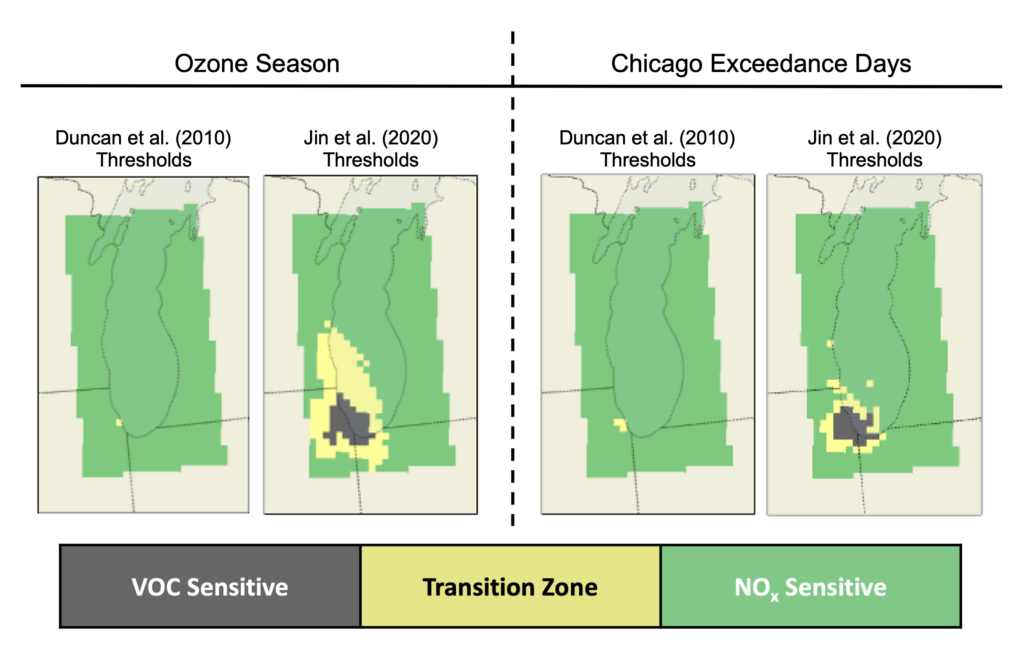At the intersection of climate change politics and chemistry
University of Wisconsin–Madison graduate student Jerrold Acdan found his research niche at the intersection of climate change politics and chemistry — in atmospheric chemistry. Acdan’s participation in a NASA program known as DEVELOP taught him how to analyze satellite data and helped him see that Earth observations could be used to address environmental and public policy issues. At that point, Acdan set out to explore how to use satellite data to study atmospheric chemistry.

For the last two years Acdan has worked with Brad Pierce, SSEC director and UW–Madison Atmospheric and Oceanic Sciences professor, to study ozone production around Lake Michigan using satellite data. Due in part to ozone transport from other regions, that area has struggled to keep ozone levels below federal air quality standards set by the US Environmental Protection Agency. Acdan’s research builds on results from the Lake Michigan Ozone Study field campaign of 2017 to look at the precursors of ozone.

UW–Madison graduate student Jerrold Acdan has been studying ozone production around Lake Michigan using satellite data. Credit: Jerrold Acdan
“Ozone production can be thought of as NOx (nitrogen oxides) sensitive or VOC (volatile organic compound) sensitive,” says Acdan.
Acdan used data from the TROPOspheric Monitoring Instrument on the Copernicus Sentinel-5 Precursor satellite and EPA Photochemical Assessment Monitoring Stations on the ground as input for a formaldehyde (a type of VOC) to nitrogen dioxide ratio (FNR) to study these sensitivities over time. A higher ratio indicates more NOx sensitivity while a lower ratio indicates more VOC sensitivity. Previous studies have attempted to establish the appropriate threshold between NOx sensitivity and VOC sensitivity. Acdan, however, focused on comparing thresholds from two studies to determine which would better apply to satellite data.
Acdan compared ozone season and ozone exceedance day composites and found that on Chicago ozone exceedance days, ozone production in the Chicago Metropolitan Area remains VOC sensitive, but the western shore of Lake Michigan tends to be more NOx sensitive. The same analysis also led Acdan to conclude that the FNR thresholds for ozone-NOx-VOC sensitivity published by Duncan et al. 2010 are more appropriate for interpreting surface measurements while those published by Jin et al. 2020 are more appropriate for interpreting satellite data in the Lake Michigan Region.
Acdan is finishing up a Master’s thesis and preparing to start his Ph.D. work in Fall 2021. He’ll be tackling a similar research project but looking at a different area of the country — analyzing data from the 2018 Long Island Sound Tropospheric Ozone Study field campaign using high resolution models and NASA airborne measurements. Long term, he plans to continue in the field of atmospheric chemistry.
“Hopefully I can go back home one day and maybe work for something like the California Air Resources Board or the EPA in California and make an impact on public health related to air quality,” says Acdan.
This work was partially supported by the Lake Michigan Air Directors Consortium (LADCO).
Duncan, B. N., Yoshida, Y., Olson, J. R., Sillman, S., Martin, R. V., Lamsal, L., … Crawford, J. H.: Application of OMI observations to a space-based indicator of NOxand VOC controls on surface ozone formation. Atmos.Environ., 44, 18, 2213-2223, doi: 10.1016/j.atmosenv.2010.03.010, 2010.
Jin, X., Fiore, A., Boersma, K.F., De Smedt, I., Valin, L.: Inferring changes in summertime surface ozone-NOx-VOC chemistry over U.S. urban areas from two decades of satellite and ground-based observations. Environ. Sci. Technol., 54, 11, 6518-6529, doi: 10.1021/acs.est.9b07785, 2020.
